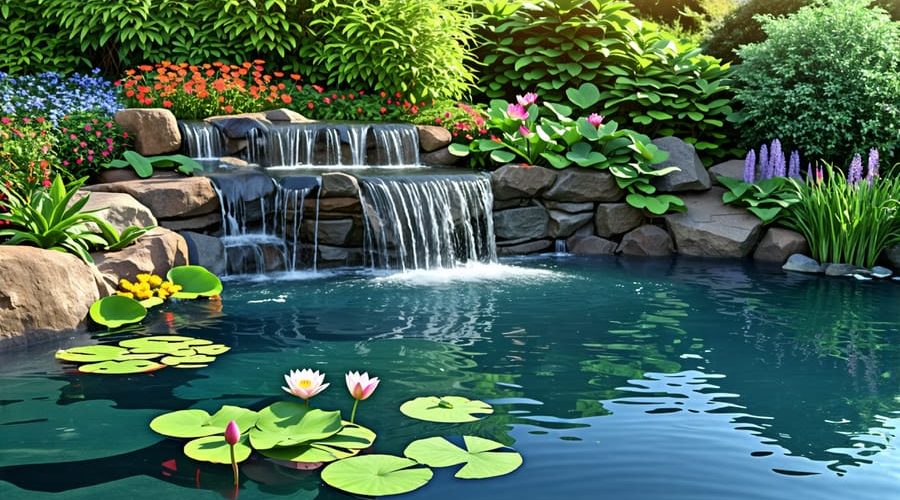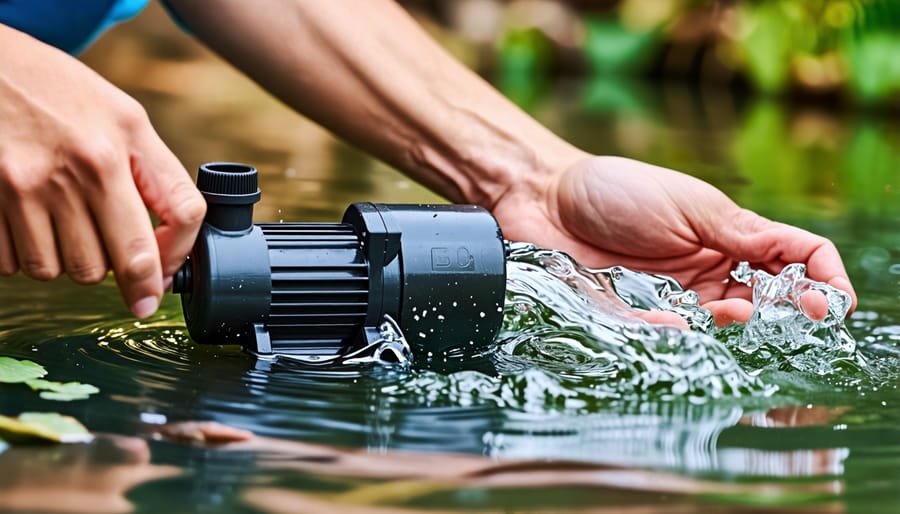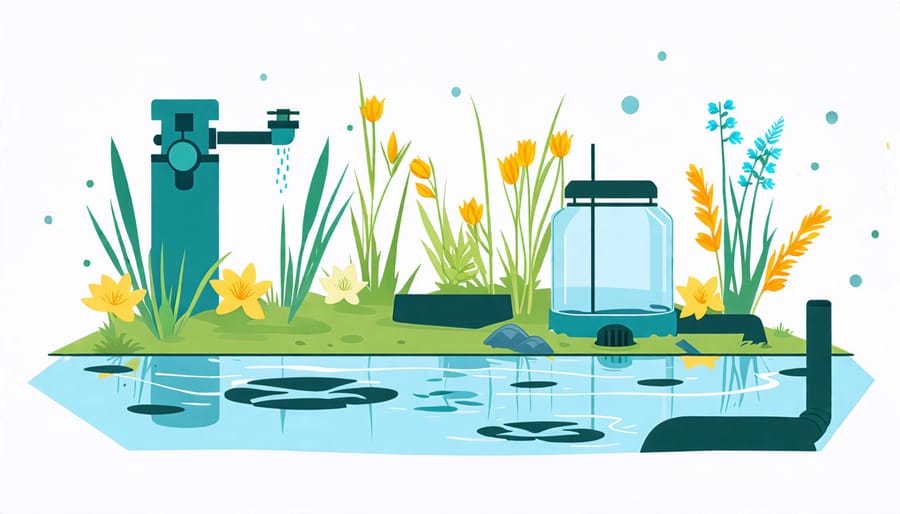
Pond Pump Perfection: Keep Your Water Oasis Crystal Clear
Regularly clean your pond pump’s intake screen to prevent clogging and maintain optimal water flow. Inspect the impeller for debris or damage, and clear any obstructions to ensure smooth rotation. Schedule annual water feature maintenance that includes disassembling, deep cleaning, and lubricating your pump to extend its lifespan. Monitor water levels and top off your pond as needed to prevent the pump from running dry and overheating.
Understanding Your Pond Pump

Submersible vs External Pumps
When choosing a pump for your pond, you’ll encounter two main types: submersible and external pumps. Submersible pumps are placed directly in the pond, making them easy to install and less visible. They’re ideal for smaller ponds or water features with minimal flow requirements. However, they can be harder to access for maintenance and may not be as powerful as external pumps.
External pumps, on the other hand, are situated outside the pond and are connected to external filters and other equipment. They offer more power and flexibility, making them suitable for larger ponds with higher flow demands. External pumps are also easier to maintain since they’re not submerged, and they often have a longer lifespan. The downside is that they require more space and can be more expensive than submersible pumps.
Ultimately, the choice between submersible and external pumps depends on your pond’s size, filtration needs, and personal preferences. Consider factors like ease of maintenance, energy efficiency, and noise levels when making your decision.
Pump Size and Flow Rate
Selecting the right pump size and flow rate is crucial for maintaining a healthy pond ecosystem. To determine the appropriate pump for your pond, first calculate the pond’s volume in gallons. As a general rule, the pump should circulate the entire pond volume once every hour. For example, a 1,000-gallon pond requires a pump with a flow rate of at least 1,000 gallons per hour (GPH).
Consider any additional features that may affect the required flow rate, such as waterfalls, fountains, or streams. These features typically need a higher flow rate to function properly. A good rule of thumb is to add an extra 100 GPH for every inch of waterfall width. So, if you have a 10-inch wide waterfall, add 1,000 GPH to your base pump requirements.
When choosing a pump, always opt for a slightly larger size than your minimum requirements to account for any head pressure loss caused by the height difference between the pump and the water outlet. Consult the pump manufacturer’s specifications to ensure it can handle your pond’s specific needs.
Regular Pump Maintenance Tasks

Cleaning the Pump and Intake Screen
Keeping your pond pump clean is crucial for maintaining its efficiency and preventing clogs. To clean the pump housing and intake screen, start by unplugging the pump and removing it from the pond. Disassemble the pump according to the manufacturer’s instructions, taking care to keep track of all parts. Using a soft-bristled brush, gently scrub the pump housing, impeller, and other components to remove any debris or algae buildup. Pay special attention to the intake screen, as this is where most clogs occur. Rinse the screen thoroughly with a hose or in a bucket of clean water. If the screen is damaged or heavily clogged, consider replacing it to ensure optimal water flow. Once all parts are clean, reassemble the pump and return it to the pond. It’s a good idea to clean your pump at least once a season, or more frequently if you notice reduced water flow or excessive debris in your pond. Regular cleaning not only extends the life of your pump but also helps maintain a healthy and beautiful pond ecosystem. With a little time and effort, you can keep your pond pump running smoothly and efficiently year after year.
Checking for Wear and Tear
Regular inspection of your pond pump is crucial to catch any signs of wear and tear before they cause significant damage. Start by visually examining the pump’s power cord for fraying, cuts, or exposed wires, which can pose a safety hazard. Check the pump housing and impeller for cracks, chips, or other physical damage that could affect its performance. Look for any discoloration or warping of plastic components, as this may indicate overheating. Assess the condition of the seals and O-rings, replacing them if they appear worn or brittle. Pay attention to unusual noises or vibrations during operation, as these can signify worn bearings or misaligned parts. By proactively identifying and addressing these issues, you can extend the life of your pond pump and ensure its reliable performance. Remember, catching problems early can save you from costly repairs or replacements down the line.
Winterizing Your Pump
To winterize your pond pump, start by disconnecting it from the power source and removing it from the water. Clean the pump thoroughly, removing any debris or algae buildup. For storage, keep the pump in a dry, frost-free location. If you plan to run the pump during winter, consider placing it deeper in the pond to prevent freezing. Insulate the pump and pipes with foam covers or heat tape to maintain a consistent temperature. Regularly check for ice formation and ensure the pump’s intake remains clear. In extremely cold climates, consider using a pond heater or aerator to maintain a small ice-free area, allowing gases to escape and preventing fish suffocation. By taking these precautions, you can protect your pump from damage and ensure a healthy pond ecosystem throughout the winter months.

Troubleshooting Common Pump Issues
Reduced Water Flow
If you notice reduced water flow from your pond pump, there could be several potential causes. First, check the pump’s intake screen for any debris or algae buildup, as this can restrict water flow. Clean the screen thoroughly to remove any obstructions. Next, inspect the impeller for damage or clogs. If the impeller is worn or broken, it may need to be replaced. Another common cause of reduced flow is a clogged or blocked pipe or hose. Disconnect the pump and flush the lines to remove any debris. If the problem persists, check for leaks in the plumbing system, as even small leaks can significantly reduce water pressure. Finally, consider the age of your pump. Over time, pump performance can decline due to wear and tear. If your pump is more than a few years old and the above solutions don’t resolve the issue, it may be time to replace it with a new, more efficient model.
Noisy Pump Operation
A noisy pond pump can be caused by several factors. Clogged or dirty filters and impellers are common culprits, restricting water flow and causing the pump to work harder, resulting in increased noise. Low water levels can also lead to noisy operation as the pump struggles to draw in enough water. To troubleshoot, first check the water level and top it up if necessary. Next, turn off the pump and remove any debris or algae buildup from the intake screen. If the noise persists, disassemble the pump and clean the impeller and housing thoroughly. Inspect for any damage or worn parts that may need replacement. If the pump still runs loudly after cleaning and reassembly, it might be due to improper installation, such as being placed on an uneven surface or too close to the pond wall, causing vibrations. Ensure the pump is positioned correctly and consider using rubber mats or foam pads to reduce vibration and noise transmission.
Complete Pump Failure
If your pond pump has completely stopped working, don’t panic. First, check the power source to ensure it’s properly plugged in and the outlet is functioning. Next, inspect the pump for any visible damage or blockages. If the impeller is jammed, gently remove any debris and see if the pump restarts. Check the pump’s intake and discharge lines for clogs, and clear them if necessary. If the pump still doesn’t work, consult the manufacturer’s manual for troubleshooting tips specific to your model. In some cases, the pump may have reached the end of its lifespan and require replacement. If you’re unsure about how to proceed or the problem persists, it’s best to contact a professional pond maintenance service for assistance. They can diagnose the issue and recommend the most appropriate solution to get your pond pump back up and running.
Conclusion
Regular pond pump maintenance is crucial for ensuring a healthy, thriving ecosystem and a serene pond environment. By implementing the tips and guidelines provided in this article, you can keep your pump running smoothly, avoid costly repairs, and maintain the beauty of your water garden. Remember to clean your pump regularly, check for any signs of wear or damage, and address issues promptly. If you encounter any problems or have further questions, don’t hesitate to consult the manufacturer’s manual or seek advice from experienced pond enthusiasts. With consistent care and attention, your pond pump will continue to be the heart of your tranquil oasis for years to come.
